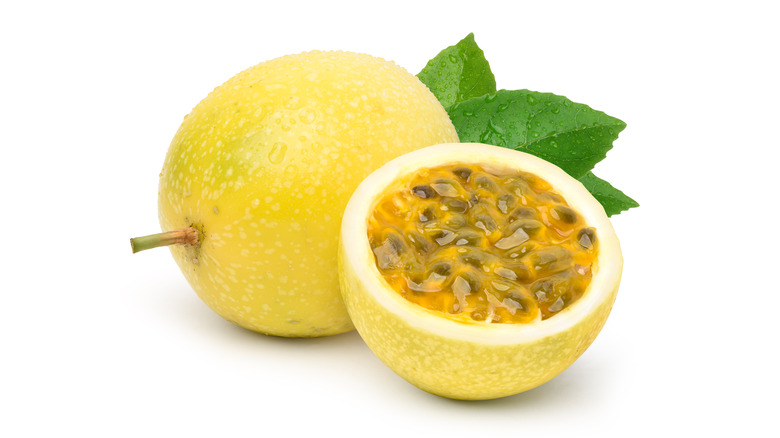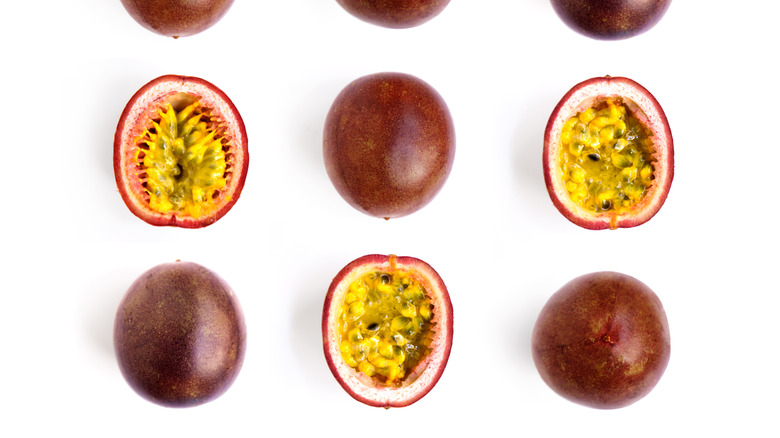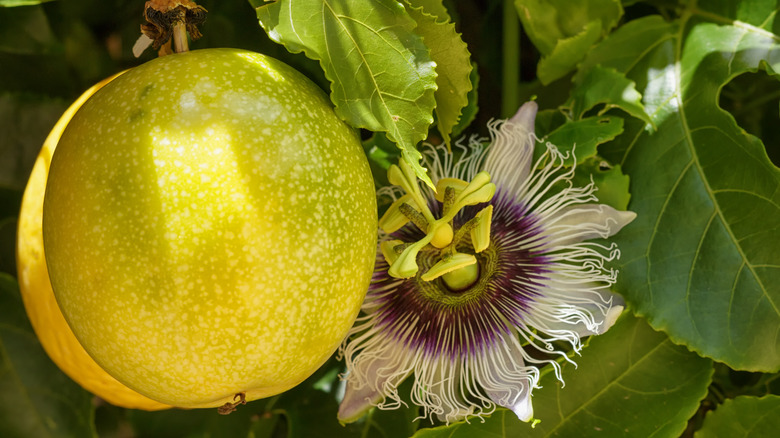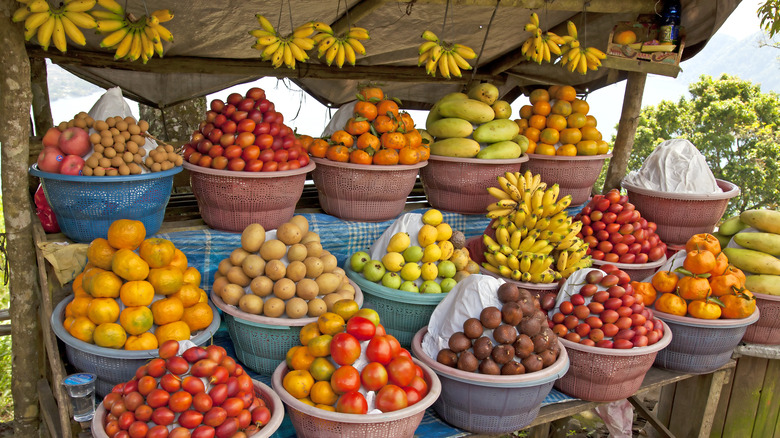What Is Maracuya And What Does It Taste Like?
Cocktails and aguas frescas. Mousses and ice creams. Jams and jellies. These are just a few of the delights in which you may have tasted maracuya, a tropical fruit related to passionfruit that is packed with crispy edible seeds and a sweet, tart, jelly-like substance. Maracuya is native to South America, in which the fruit has become popularized with recipes both sweet and savory.
This passionfruit variety has three main layers: Yellow skin, white pith, and a hollow interior containing dark brown seeds covered in a juicy, floral-tasting, gelatinous yellow pulp, explains Specialty Produce. The tropical fruit is high in vitamins C and A, which may benefit your immune system and eyesight, and may also have calming and anti-inflammatory properties, Healthline reports. Even better: It's an easy fruit to enjoy since you can just cut it in half, scoop out its flesh, and spoon it onto your breakfast or right into your mouth.
Is maracuya the same as passionfruit?
To answer your most burning question: Yes and no. Maracuya is the Spanish word for passionfruit, and it is also in the same botanical family as passionfruit. However, maracuya is a specific type of passionfruit known as yellow passionfruit — or passiflora edulis forma flavicarpa, which means yellow or gold in Latin, explains Storyteller.Travel.
Stateside, people may be more familiar with purple-skinned passionfruit rather than maracuya. Besides the color of their exterior, the two fruits are similar in flavor, though many say maracuya has a stronger, more tart flavor. Why are the two fruits often confused? LSG Group reports that manufacturers often use pictures of purple passionfruit on packaging for maracuya-flavored products because of maracuya's "unspectacular" appearance. To add to the confusion, the terms maracuya and granadilla, another similar fruit in the passiflora family, are often used interchangeably. Granadilla, however, is more gold than yellow, and its flavor is sweeter than that of a maracuya, per Storyteller.Travel.
Where, how, and when maracuya is grown
Maracuya is native to South American rainforests and has been cultivated for centuries around the world from Australia to North America, according to Specialty Produce. The fruit was first identified as maracuya in Brazil in 1932, but botanists still dispute its origins. Some think it was developed as a hybrid of purple passionfruit and sweet granadilla, and others think it was a random mutation found in Australia. These days, it is grown primarily in the hot, tropical climates of Peru, Venezuela, Brazil, Colombia, and Guyana, where there is no frost.
Maracuya is known almost as well for its flashy flowers as it is for its flavor. The fruit, technically a berry, grows on a vining plant with fringe-like, white-tipped purple flowers with large green sepals in the center (via Harvest to Table). The fruit is usually ready to be harvested in mid-to-late summer, when it falls to the ground or when its yellow color is fully developed. It will last for about two weeks once picked.
How to pick a good maracuya
Maracuya grows "like weeds" throughout Latin America and is very affordable at most markets there, according to Ecuadorian blogger Laylita. If you live in the United States, though, you've probably noticed that maracuya and other types of passionfruit can be expensive. That's because the fruit is usually imported and is a "volatile" crop, Foodiosity explains, meaning that it's picky about its growing conditions and can often vary in quality from one year to the next. If you're going to pay upwards of $3 for a small fruit with just a few precious bites of pulp inside, you want to know how to pick a good one.
Foodiosity says that you should buy maracuya when it's soft, as you would for figs or avocados, and sweet-smelling, like peaches and nectarines. Its skin should be shiny, bright yellow, and a little wrinkly, and the fruit should be egg-shaped and feel heavy for its size. If it's green, it needs more time to ripen, and if it feels light, it's likely dried out inside. You'll know you picked a good maracuya when its interior is juicy, sweet, and tart, while unripe ones will be sourer (via Flavors of Bogota).
Common ways to use maracuya
Many people enjoy maracuya on its own or as a topping for yogurt: Just slice the fruit in half and scoop out its flesh with a spoon, according to the Los Angeles Times. It's also easy to turn the flesh into a quick juice, smoothie, or cocktail, as is customary in many parts of South America. Blend the fruit with ice, your liquid of choice, and more fruit, like banana. There's no need to remove the seeds, as they're perfectly edible, pleasantly crispy, and can add an interesting texture to your drink or dish.
Latin American cuisines typically celebrate the sweetness and acidity of maracuya in signature desserts. There's postre de maracuya, a creamy, layered confection of whipped maracuya filling with a vanilla cookie crust (via Flavors of Bogota). In Brazil, it's common to make maracuya mousse with cream, gelatin, and sweetened condensed milk (via Laylita). When you sample ceviche or other refreshing seafood specialties in Peru, you'll enjoy washing each bite down with a maracuya pisco sour, Eat Peru suggests.
Surprising ways to enjoy maracuya
Maracuya pairs incredibly well with chocolate, says Beyond Mere Sustenance. Try her Peruvian-inspired dessert, a rich and cool combination of tart maracuya curd and flourless chocolate cake. For a larger format dessert, Katie at the Kitchen Door makes a chocolate mousse pie with a cookie crust and maracuya filling. And if you're intrigued by the pairing but don't want to cook, many chocolatiers make chocolate and passion fruit truffles, like Vosges Haut Chocolat.
Finally, maracuya is also used in savory applications — think pineapple in al pastor or lime juice as a marinade for fajitas and seafood. Flavors of Bogota recommends using maracuya in a sauce for proteins like chicken, pork, or salmon. My Colombian Recipes combines maracuya puree with heavy cream and reduces it over heat for a thickened mixture to be poured over cumin-spiced chicken. In countries such as Colombia, it's customary to use maracuya in the marinade for ceviche (via YouTube). Just combine with lime juice, cilantro, and onion, taste for seasoning, and enjoy on a hot day.





